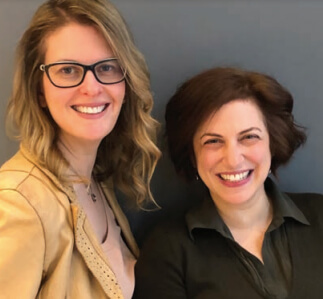Above: R.B. Kitaj. Eclipse of God (After the Uccello Panel Called Breaking Down the Jew's Door), 1997-2000. Oil and charcoal on canvas, 35 15/16 in. x 47 15/16 in. Purchase: Oscar and Regina Gruss Memorial and S. H. and Helen R. Scheuer Family Foundation Funds, 2000-71. Photo by Richard Goodbody, Inc. Photo Credit: The Jewish Museum, New York / Art Resource, NY. © 2020 R.B. Kitaj Estate

Mira Sucharov & Chaya Halberstam
With the rise of white nationalism across the globe, bloody attacks on houses of worship, and an increase in hateful discourse generally, we felt that the current moment called for an investigation into hate: Who hates whom and why? What are hatred’s textual sources? Where do we see it in art, literature, and film? How is it manifested politically and what has it looked like historically? What is the legal relationship between antihate provisions and free-speech allowances? What are hate’s impacts and aftershocks? What is the interplay between hate and love, hatred and contempt, and hatred and self-hatred? And what is the relationship between Jewish difference and hate?
In a Jewish Studies publication, antisemitism is the most obvious form of hatred that lends itself to a scholarly investigation, though in this issue we also explore Islamophobia, homophobia, classism, and anti-Black racism. Our issue’s authors show us how hate is reflected and constructed in novels, poetry, film, and sacred texts; they reveal the contours of hate from the streets of Kiryat Hayim in Israel to academic conferences to nineteenth-century saloons; and they help us figure out how to manage hate in professional settings and university classrooms. Two photo essays reveal the power of images in conveying and responding to hate.
Hate also straddles the territory between a visceral, unwitting emotion—one in the basket of emotions we all carry with us one way or another as we go about our daily lives—and a distinct ideology—that, like any political position, can be challenged, suppressed, or ignited through systemic means. If it’s an emotion, an empathic or psychoanalytic approach might suggest that it be observed nonjudgmentally; attempts to suppress it forcefully might only serve to intensify it. But if it is a political ideology—that operates intellectually and is reinforced communally, then maybe it should be subject to forceful criticism and zero tolerance. Various pieces in this issue reflect these differing perspectives. Some attempt to negotiate between these poles.
There are glimpses of optimism, too. Sometimes the recognition of mutual hatred can bring alienated parties together, as in the dialogue groups taking place between Jews and Muslims in France. Other times, a community comes together to send succor and healing towards the victims of hate, as happened in the city of Pittsburgh in the aftermath of the Tree of Life Synagogue shooting. And the methodological tool of nonjudgmental ethnography—as in the relationship between a researcher and his hate-speaking subjects, in this case of members of the Westboro Baptist Church— can be a powerful tool for deep understanding. And sometimes, the recognition of ingrained and unrelenting hate mobilizes a community or a people to fight back, as in Argentina in the 1960s. We feature essays in this issue under the heading “Responding to Hate” to explore a variety of responses from empathy and communal solidarity to violent uprisings.
If hate is inevitable, we ought at least to shine a light on its mechanisms and manifestations. And if it's not, we must seek to understand how to end it.
Chaya Halberstam
King’s University College
Mira Sucharov
Carleton University